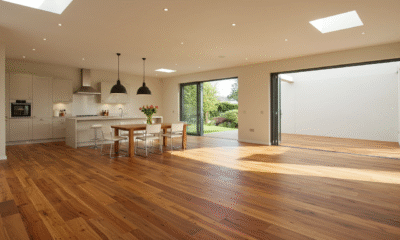

Environment
8 Eco-Friendly Home Features To Check For When Buying A House
There’s no escaping the headlines, the way we choose to live impacts the environment.
The data doesn’t paint a great picture, The average British household produces an estimated 2.7 tonnes of CO2 a year—which is A LOT. And the bad news is rather than reducing, according to a report published by the Committee on Climate Change in May 2019 household emissions are going up.
This is increasingly important to today’s homebuyers who are more environmentally aware than previous generations and want to purchase eco-friendly homes.
And, it’s not just about reducing the carbon footprint, by lowering energy consumption, you also benefit from huge savings on your bills.
So, how do you know a property is eco-friendly?
Here are eight things every property needs to have to be energy efficient and environmentally friendly.
1. Has the seller used eco-friendly materials?
Eco-friendly materials have a low environmental impact and include recycled materials. For instance, salvaged or reclaimed wood. Also, look out for materials that encourage sustainable energy like recycled steel, bamboo, straw bales and precast concrete.
Sustainable materials are important as they reduce your energy consumption, so you don’t have to rely so much on natural resources like oil and gas that just accelerate global warming.
2. Is the loft Insulated?
Insulating your home is one of the best ways to lower your energy use. These days, you’d expect that most properties have an insulated loft. Yes, it does cost at the beginning, but the savings made on your energy bills quickly recoup your investment within a few years.
Also, when visiting a property ask about the insulation material—is it eco-friendly like e.g., cellulose insulation, which is made from recycled newspapers?
3. Are there solar panels?
Even though the UK government has now closed its incentive scheme for installing solar panels, they’re still worthwhile to have as they will save you energy and money and reduce the amount of carbon emission your home produces.
There are two types of solar panel, these are:
- Photovoltaic solar panels (known as solar PV). These panels capture the sun’s energy and make electricity. You can store and use this to power everything from your kettle to your tv. This can be used to power household goods and lighting.
- Solar thermal—this can be used to heat water, which is great news if you have central heating and need to lower the costs of using it.
4. Check the windows
Make sure windows are double glazing (rather than single), and if possible, avoid ones that use UPVC, which releases toxins. Instead, window frames should be either made from either wood or metal as they’re not only more insulating, but also less toxic and will last forever.
5. Check the Energy Performance Certificate (EPC)
When a buying a property it’s vital you check its EPC—this tells how much energy the property uses and information about how many CO2 emissions it produces.
Every property is graded on a scale from A to G where A is the most energy efficient and a G graded property the least. As a rule of thumb, the average current grading is D.
6. Is there underfloor heating?
Radiators are surprisingly inefficient especially compared to underfloor heating. Although you mainly think of new build properties having underfloor heating, it can be installed in older properties too.
Usually, if a property does have underfloor heating, you’re most likely to find it installed in the bathroom.
7. Do they use LED lights?
Light emitting diodes known more commonly as LED’s are small, solid light bulbs which last far longer than normal light bulbs and use far less energy—they are around 90% more efficient.
8. Check for draughts
Unblocked chimneys, or ill-fitting front doors and windows are common culprits behind lowering your home’s energy efficiency rating as they allow energy to escape and be wasted.
A well draught-proofed home should have the following:
- Good ventilation e.g. extractor fans, wall vents, underfloor airbricks
- All unwanted gaps are blocked
- Windows have draught-proofing strips
- Unused chimneys are blocked
- The front door has padded draught-excluders
Green Solutions to Look for When Buying a Home
Are you looking to buy a green home? You need to make sure that you make the decisions carefully. The process is pretty straightforward. Just follow the tips listed above.
Need to sell your house fast before you can buy?
If you’ve found your perfect new home, but you’re struggling to sell your current property, don’t worry. Companies like House Buy Fast will buy your house, regardless of its condition or location.


 Environment9 months ago
Environment9 months agoAre Polymer Banknotes: an Eco-Friendly Trend or a Groundswell?

 Environment11 months ago
Environment11 months agoEco-Friendly Home Improvements: Top 7 Upgrades for 2025

 Features8 months ago
Features8 months agoEco-Friendly Cryptocurrencies: Sustainable Investment Choices

 Features9 months ago
Features9 months agoEco-Friendly Crypto Traders Must Find the Right Exchange



























